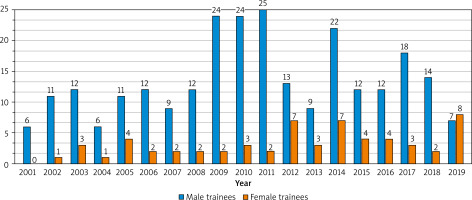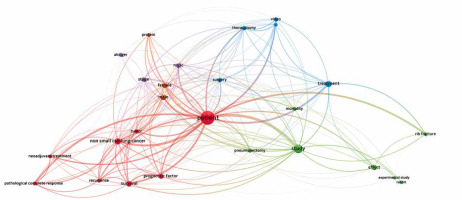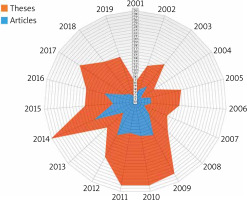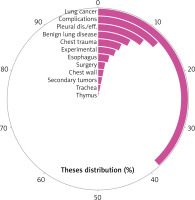Introduction
In Turkey, after graduation from the medical faculty, candidates who pass the medical specialty examination can apply for a 5-year thoracic surgery residency without the need for any prior residency program such as general surgery. Although there are several disparities between centers, all trainees must have a certain knowledge level and ability to perform most procedures in the field. To graduate from the program, one should sufficiently prepare and present theses with a proper scientific investigation [1].
Publishing a scientific article from the thesis is seen as a start to an academic career for clinicians and is accepted as one of the primary criteria for being able to work in academia in our country. The journal index and the citations of the articles reflect the scientific power of the theses and their contribution to the literature [2].
There are limited studies in the literature regarding medical theses from certain medical specialties in Turkey, such as orthopedics, anesthesiology, emergency medicine, neurosurgery, public health, and general surgery [3–9]. There is a lack of studies of thoracic surgical perspectives from Turkey and the world.
Aim
We aimed to evaluate the medical specialty theses produced in the field of thoracic surgery in Turkey between January 1st, 2001, and December 31st, 2019, in terms of publication and other bibliometric parameters. These will enlighten a portion of the scientific ability of thoracic surgery training programs. To the best of our knowledge, this is the first publication in the literature regarding the bibliometrics of the thesis in the thoracic surgery field.
Material and methods
In this cross-sectional study, we investigated thoracic surgery theses. To obtain the data, we searched through the National Thesis Center search engine using the keyword “thoracic surgery” and the category of expertise in medicine. The time frame was between January 1st, 2001, and December 31st, 2019, to maximize access to the original thesis and any possible publications. After excluding 788 studies in cardiovascular and other disciplines (anesthesiology, medical oncology, hematology, and others), 319 studies were listed under the thoracic surgery category.
Gender, the type of training facility, the research method, publication status, publication time, citation count, the publisher journals’ indexes, Journal Citation Reports (JCR), and impact factors (IF) were collected. We obtained these bibliometric parameters through Google Scholar, Web of Science Basic Search, and Web of Science Master Journal List.
The software used to evaluate and visualize the bibliometric network through keyword co-occurrence to understand the trend of research in the field of thoracic surgery was VOSviewer version 1.6.18 (Centre for Science and Technology Studies, Leiden University, The Netherlands).
Statistical analysis
The continuous variables were analyzed using an independent t-test or Mann-Whitney U test, and the categorical variables using the χ2 test. The Pearson correlation test was applied to investigate the relationship between independent variables. We used SPSS for Windows version 25.0 (IBM Corporation, Armonk, NY, United States) program for statistical analysis. The statistical significance level was accepted as p < 0.05.
Results
Sixty (18.8%) of the authors of 319 theses evaluated were women. Residency students at universities presented 262 of these, and 57 belonged to clinicians from specialty training in Training and Research Hospitals. The retrospective design included 287 studies, and 32 were experimental or prospective (Table I).
Table I
Comparison of gender groups in terms of bibliometric parameters
Of those, 123 (38.5%) of the theses reached publication. Twenty-nine were from 2014, which is the highest number within the period of our research. The publishing rate as original articles was the highest in 2016 at 62.5% and the lowest in 2019 at 13% (Figure 1).
Sixty-six (53.7%) of these publications were in journals listed in SCI/SCI-E, 8 in Emerging Sources Citation Index (ESCI), 3 in other international indexes, and 46 in the national index. The mean time from the thesis to publication was 4.31 ±2.95 years, significantly shorter at 3.3 years in female residents (p = 0.029) (Table I).
There was no significant relationship between gender, educational institutions, publication rate, time to publication, journal index, research method, number of citations, and author name order. There was no correlation between the educational institution and publication status, field index, citation count, and author name. The portion of experimental and prospective studies was higher in universities (p = 0.07). Again, the time to publication for the theses at the university was shorter (p = 0.097) (Table II).
Table II
Comparison of gender groups in terms of bibliometric parameters
We saw male dominance in the number of trainees. Only 18.8% of the researchers were female, and the gap increased throughout the year until recent years. In 2019, more female trainees presented theses and became a surgeon than any year before, and they even outnumbered male trainees for the first time, hitting 53.3% (Figure 2).
Figure 2
Gender distribution of the thoracic surgery trainees presented their theses and graduated from their training programs over the years

The number of citations of the publications published in the SCI/SCI-E indexes was significantly high (p < 0.001). Again, the publication time of these studies was shorter (p < 0.001). The time to publication for experimental and prospective studies was also shorter (p = 0.039).
Lung (cancer and benign diseases) and pleura are the leading focus of more than half of the studies we investigated. In addition, the surgical aspect and complication management were the focus of around 15% of the theses conducted and presented during the mentioned period. However, diagnosis and treatment of esophageal and tracheal conditions are limited to only five and three studies (Figure 3).
Keyword analysis run via VOSviewer software revealed and visualized the trend of the research field. Non-small cell lung cancer is the leading cluster accompanied by these keywords: stage, survival, prognostic factor, recurrence, neoadjuvant treatment, and complete pathological response. Another density was around the study with the following keywords: treatment, experimental, rabbit, rib fracture, surgery, NSCLC, pneumonectomy, treatment, and mortality (Figure 4).
Figure 4
Keyword analysis run via VOSviewer software revealed and visualized the trend of the research field

Surgical journals indexed in SCI-E according to the JCR Category that published the original articles originating from certain theses are listed (Table III). Annals of Thoracic and Cardiovascular Surgery is the journal with the highest IF (4.617) in the list, while the Turkish Journal of Thoracic and Cardiovascular Surgery published the highest number (34) of articles (Table III).
Table III
List and bibliometric parameters of the surgical journals where the articles were published
Discussion
Every medical doctor must conduct and present an original study for their specialty thesis [1]. As a scientific aspect of training in medical specialties, publishing articles from specialty theses is considered crucial and required to apply for a position in academic facilities. Furthermore, the index of the journal and the citations represent the scientific power of the theses and their contribution to the literature [2].
There are limited studies on bibliometric analysis of medical specialties in Turkey. In an article by Koca et al., the publication in scientific journals rate of the orthopedic theses was 14.9%, and the rate of the experimental studies was 25.6% in the period 1974–2012 [2]. According to Baysan et al., 81.3% of the orthopedic theses were conducted in university hospitals [7].
Erim and Petekkaya suggested that psychiatry specialization theses between 1981 and 2018 have a 37.7% publishing rate in journals, 37.9% in 2001–2018, and 28.5% in SCI/SCI-E journals. Trainees from universities wrote 82% of the theses, and 2.7% of the studies were prospective/experimental [8]. In the neurosurgical field between 2000 and 2017, the rate is 37.9% with an average time to publication of 3.8 ±2.7 years [3]. Between 2004 and 2013, 18% of the theses were published in SCI/SCI-E journals [10].
Cevik et al. reported that emergency medicine theses between 1998 and 2013 have a 27.1% publication rate. Around 14.9% of researchers published their studies in SCI/SCI-E journals, and 20% were experimental [4]. Between 1998 and 2018, 20.5% of general surgery graduates managed to get their research published in a journal, 14.4% indexed in SCI/SCI-E, and 49.3% were experimental, according to Ferhatoğlu et al. [5].
In another study by Sipahi et al., the publication rate of public health theses was 30% and 11.9% in international journals, yet the authors did not mention the research methodology and the JCR category [6].
In our study, the overall publication rate of the thoracic surgery theses was 38.5%, which is higher than any other medical specialties reported earlier in the literature from Turkey. The publication rate in SCI/SCI-E journals was 20.6%, which was below the psychiatry field but higher than others. These results can suggest the increased academic tendency in the discipline and interest of the trainees.
Around 82% of the theses were from universities in our study, almost equal to any other specialties in certain studies. This rate reveals the university’s dominance over the TRH in surgical and other specialty training in Turkey.
Since there was no gender analysis in the studies mentioned above, we cannot compare our results. Among all, 18.8% of the researchers were female, and they published their studies not at a higher rate but significantly earlier in their careers. The gap between the number of male and female trainees was closed in 2019, but it is too early to say the disparity in the surgical specialties is over.
Only 10% of the studies were prospective/experimental, which is lower than most other specialties. That indicated the lack of interest or availability for animal experiments and clinical studies. Not every faculty or hospital has access to labs and enough patient volume to conduct experimental and case-control studies.
We investigated the subjects through the National Theses Center, WoS, and Google Scholar databases for the most valid results. Yet the accuracy of these findings is limited to the sources. Although we have narrowed the time frame to the period 2001–2019 to maximize the availability of theses and accessibility of the journals, it is still possible that we did not manage to find every single thesis presented and every publication printed in national or international journals. Furthermore, some studies have broader or shorter periods than ours, which can affect the ratio difference between them.
Conclusions
The publication rate of theses in thoracic surgery was 38.5%, the highest in the literature for specialty theses in Turkey. Thoracic surgery specialty theses have a high publication rate in SCI/SCI-E journals compared to other specialties. There was no statistically significant difference between the parameters examined for university and TRH. Articles published in SCI/SCI-E journals have significantly more citations. In experimental/prospective studies, the time to publication is considerably shorter. However, there were limited experimental studies, which indicates the lack of interest or availability for this type of study. Female researchers published their thesis in a scientific journal significantly sooner than their male colleagues, even though they were in the minority. With this study, the bibliometric analysis of specialty theses in the thoracic surgery field has been studied and reported for the first time in the literature.







